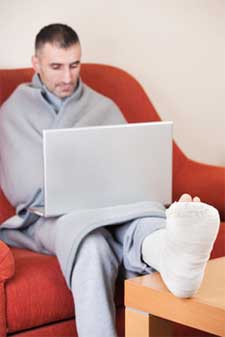If you have been injured because of a slip and fall incident on the property of another person or business, you may be entitled to compensation. Slip and fall personal injury accidents are a type of personal injury claim. Specifically, they are accidents that result from a stability failure between the injured party’s shoe and the surface of the floor. In other words, the fall must be the result of slippery floors in order for a viable lawsuit to exist, but there are a number of considerations which determine a lawsuit’s viability and not just the condition of the floor on which your slip and fall incident occurred.

Responsibility for Slip and Fall Accidents
The owner of the property where the accident occurred and the injured individual may both hold varying degrees of responsibility for slip and fall accident. The property owner is responsible for maintaining a safe environment and the individual has a responsibility to use proper care in his or her own actions as well. This includes taking additional measures to avoid injury when walking on a surface that may be slippery or icy, or a surface on which something may have been spilled, for example.
The examination of responsibility, or in other words determining negligence in a slip and fall case, is a central part of any personal injury lawsuit and having a viable case for a slip and fall injury requires that you can substantiate that the majority of the responsibility for the injuries you suffered falls on the property owner.
Comparative Negligence and Compensation
In examining responsibility for slip and fall accidents, courts look at percentages or the degree of liability for each party involved in the case. The court will examine the circumstances and the responsibilities of both parties to prevent or avoid harm. A percentage of responsibility will be assigned to each party based on the circumstances of the specific case. That percentage is considered comparative negligence and will determine to what extent an injured individual may be entitled to compensation, including how much.
In comparative negligence, even if you are partially at fault for your own personal injury, if the property owner is determined to have a greater degree of responsibility for the injury given the specific circumstances of the case, then you could still be entitled to receive compensation.
Hazardous Condition Cases
In addition to the many slip and fall accident scenarios, a good amount of slip and fall personal injury lawsuits filed are based on an argument that hazardous conditions existed and were at fault for the injury. A hazardous condition is a situation in which there is a strong potential for injury. For example, a broken stair or a sidewalk in which there are marked crevasses or cracks that are covered with snow and therefore not obvious to the individual walking on the surface would be instances of permanent hazardous conditions.
Cases involving hazardous conditions such as these are quite viable in terms of personal injury slip and fall lawsuits. The reason for this is that the injured person’s responsibility and comparative negligence is relatively low. The property owner’s degree of responsibility for a permanent hazardous condition is high and therefore, their liability for any injury that may result from the hazard is high as well.
Hazardous condition arguments may also revolve around temporary conditions, like ice on a sidewalk which results in a slip and fall injury. In temporary hazard cases, the degree of responsibility the property owner has for the injury can vary. A primary factor in the determination of the case will be the whether the property owner had enough time to become aware of the temporary hazard and address the situation accordingly in order to reduce the chances of injury occurring.
While permanent hazardous conditions lawsuits are often easier to argue, given the property owner should have taken measures to deal with the problem, temporary hazards are much less clear cut under the law. These kinds of cases are therefore more difficult to prove and harder to win as a result, though the specific circumstances will always play into whether or not a slip and fall personal injury case is viable and a personal injury attorney familiar with arguing such cases will be able to help you decide if the lawsuit is worth pursuing.
For more information about a slip and fall at a store, see What You Need to Know if You Slip and Fall at a Large Store.
Accident Reports
Any personal injury case must include substantial proof of the incident that occurred and the injury which resulted from that incident. Ideally, an accident report will be completed immediately after a slip and fall incident. For this to occur, you must report the incident to the property owner at the time.
The accident report would include information about the conditions under which the slip and fall happened, including all details regarding the environment, like the lighting conditions, the floor or ground surface, and any discernible hazards present. The type of shoes you’re wearing and your own mental and physical state at the time of the fall can also become a part of the incident report. Statements from any witnesses would also be taken during the accident reporting process.
Slip and Fall Claims Settlements
Understanding the steps on how to settle your slip and fall personal injury claim is key. It's important to know how to proceed after the accident and what tasks need to get done to be successful.
Hiring a Slip and Fall Attorney
It is highly recommended that you consult a slip and fall attorney to see if you have a viable personal injury case. Your attorney will be able to evaluate your case for free and tell you if you have a case that is worth pursuing.
Click here to be contacted by a slip and fall attorney in your area for a free evaluation of your slip and fall personal injury claim.